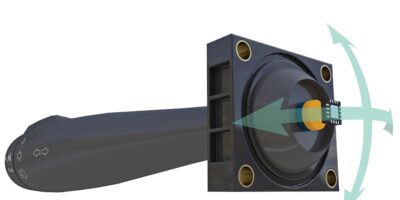3D Hall-effect sensor has magnetic node for contactless sensing
Incorporating a micropower magnetic node, the MLX90395 Triaxis Magnetometer Node offers contactless 3D sensing for automotive and industrial applications. Available from Melexis, the MLX90395 is AEC-Q100-qualified for use in automotive, as well as industrial applications. The monolithic sensor uses the Hall effect to provide contactless sensing in three dimensions. The dual-die version of the MLX90395 provides redundancy for demanding scenarios, such as gear lever position sensing, in automotive designs.
The MLX90395 offers interface choices of I2C and SPI, for integration into an automotive or industrial control environment. There are medium-field (50 mT) and high-field (120 mT) versions all available in three package options, namely SOIC-8, TSSOP-16 (dual-die for redundancy) and QFN-16 (with wettable flanks). All package options are qualified to AEC-Q100 covering the extended temperature range for -40 to +125 degrees C and are RoHS-compliant.
The selectable digital output provides 16-bit resolution for X, Y and Z magnetic field measurements, enabling the host processor, DSP, microcontroller or digital signal controller to decode the absolute position of any magnet as it passes the sensor.
The MLX90395 is smaller and more power-efficient than alternative Hall effect sensors, says Melexis, attributing it, in part, to its proprietarty Triaxis technology which contributes to a low power consumption. Idle current is 1.4 microA, standby current is 2.4 microA and supply current is 4mA or less.
In addition to magnetic field sensors, the MLX90395 integrates a temperature sensor and supply voltage monitor. The sensor features three state machines and operates in single measurement, burst mode or wake-up on change modes. Engineers can select which magnetic field is measured and the frequency of measurement, to finetune energy efficiency. The filtering and sampling times can also be adjusted to optimise noise versus bandwidth.
Operational modes can be defined and selected at runtime through the SPI or I2C interfaces, allowing multiple sensors to form part of a sensor cluster controlled by a single microcontroller. The bus protocol (SPI or I2C) is also selectable, running at up to 10 MHz for SPI and 1 MHz for I2C.
Each sensor has a unique 48-bit ID number, provided during the manufacturing process, and contains additional free space to store customer traceability information.




